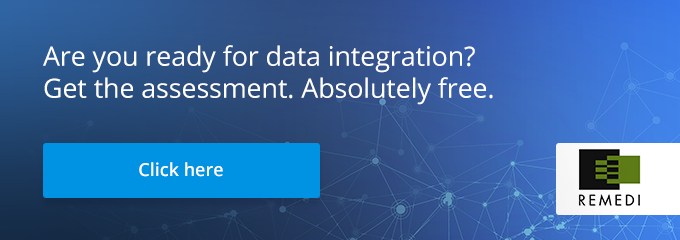
2019 is rapidly approaching. This could be the year you embark on a data integration project. However, for the project to succeed, you must assess your data.
We have identified the top 10 questions (with some sub-questions thrown in for good measure) you need to answer to figure out whether you are ready to launch a data integration project and what steps you should take to prepare yourself. Read on to discover what questions you should ask to start this journey.
#1. Where Does Your Information Originate?
Your data must come from somewhere. Knowing its source is crucial for a successful data integration.
Why does it matter so much? When you know where your data comes from, you can create a map of those sources and how they connect to one another. You do not want to leave any sources out during the integration process. Think of this as an exercise in creating an inventory of data sources.
#2. How Often Do You Collect Data (and How Do You Do It)?
All right, that is actually two questions. However, they are crucial ones.
For integration to work, you also need to know how often the systems you use collect data. Why is this important? The answer to this question determines the freshness of the data. We will use an ERP system as an example; legacy ERP systems might not collect data more than once a day, meaning it will not be up-to-date if you access it before it has been updated.
A related question is how you collect data. Which systems gather the data, and how do they do it? This is also crucial to know because if those methods are not compatible with your integration platform, that is a significant problem.
#3. What Systems Hold Your Data?
To integrate data, you must be able to answer the question, “Where is my data located and in how many systems does it reside?” The answer to this question will inform strategies going forward.
How so? If your systems are legacy, they might not connect to a data integration platform. Or, they might require connections which are brittle and easy to break. That could affect the success of the data integration project.
#4. What Kind of Data Do You Have?
You absolutely must know what kind of information you have. In addition, is it structured or unstructured? What are the data’s format and size?
The previous questions are crucial. For a start, if data is in heterogeneous formats, it must be prepared and transformed so it will be in the same format for integration. Second, unstructured data can be challenging to integrate with structured data. A third question to ask is whether your data integration platform solution can handle the data format and sizes you need; you do not want to make an investment in a solution only to discover that it will not meet your needs.
#5. What Is the Quality of Your Data?
If your data is not of the highest quality, integrating information from different sources will be a wasted effort. Data must be up-to-date and accurate for it to be of any use. How can you make good decisions if you cannot trust your data?
Before you start a data integration project, a vital first step is to perform a data confidence index. This involves assigning scores to transactional information in your digital storage. If you do not trust a particular bit of information, do not use it.
A good rule of thumb is that data management should be part of your information life-cycle. That means putting data governance standards in place that are thoughtful and that put quality at the forefront.
#6. What Applications Draw Data from Your Database?
You know you need to integrate disparate data sources into one place. However, data integration goes beyond that. Applications will draw that information and consume it to meet the needs of business users.
The question above leads to another crucial question; will the data integration platform “talk” to the applications that need to draw data from it? If they cannot, your data integration project will not get far.

#7. What Are Your Business Needs Now, and What Will They Be in the Future?
This is a less technical, yet no less important query. The first part of the question might seem like it is easy to answer, while the second part might leave you saying, “Well, how will I know what I need in the future?” Yet, you must be able to answer both parts of that question for a successful data integration project.
It would seem self-evident that data integration is meant to drive the business forward. Despite that seemingly obvious bit of knowledge, it is amazing how easy it is to become distracted by the tools a data integration solution offers. Those tools might be nice, but you absolutely must ask yourself, “Does this meet my business needs?”
So, how do you address the second part of this question? Admittedly, it is not easy to think about what you need in the future – how do you know? You might not be aware of what you will need, though that should not stop you from choosing a solution that will adapt.
You need a solution with the flexibility to accommodate changing data requirements. A data integration should be built to address future challenges that will arise; you do not want something that is so brittle it cannot keep up with the times.
#8. What Resources Does the IT Department Need To Achieve Success?
While it is critical to keep business needs top of mind, you cannot neglect what the IT department needs to complete the integration project. Without the proper resources (technical, financial, and human), the project will not achieve the desired results.
Determining the needs of your IT department should be done with deliberation and care. Writing down the obvious needs (you will need some employees for a certain number of hours) is vital, though you cannot overlook other, less evident needs.
For example, does your IT staff have the knowledge and skills to carry out this project? If not, what would it take to change that situation? Do you need to outsource parts, or all, of the project?
You also have to examine your current technological resources. Will this new data integration platform play nicely with the other systems in place? Is your network health sufficient to support such a platform? These questions need answers before you move forward.
#9. What Are the Cost Constraints Now and Going Forward?
In a perfect world, you could afford whatever you needed – technology, human resources, hardware, etc. Unfortunately, we do not live in a perfect world, and financial resources are limited. Your financial resources will play a significant role in determining what kind of data integration platform you choose.
It is easier to figure out your current financial constraints, though you must remember what potential financial limitations might crop up. Such an approach is challenging, so how do you figure out what constraints might affect you in the future? One thing to think about is how much maintenance the solution will require; can you afford those costs? Another issue to consider is how long your data integration solution will last into the future; is it adaptable for future requirements, or will it not last more than a few years?
#10. What Use Cases Can You Identify?
You might have read or heard a steady stream of opinions on why you should implement a data integration solution right this second. Yet, you must be able to answer this crucial question: why?
Identifying use cases for data integration solutions is vital. When you implement new software, you need to understand exactly for what it is going to be used. Otherwise, you cannot measure success because you do not know if you are meeting your goals.
What Happens If You Do Not Know How to Ask the Right Questions?
Undertaking a data integration needs assessment does not come as second nature to many organizations, and there is nothing wrong with that. Unless data integration is your core business, you are most likely going to be unfamiliar with it. How do you solve that problem?
Finding a trusted partner with the experience to navigate the entire process will ensure success. Search for a partner with experience in your field and with companies of your size. You need a data integration consultant who does not see your company as an opportunity to make money; what you need is someone who wants to forge a long-term relationship and who will give advice based on your best interests.
Before you know it, 2019 will be here. Are you ready for data integration? Get the assessment. Absolutely free.



